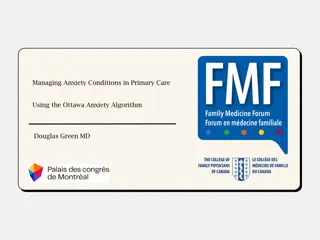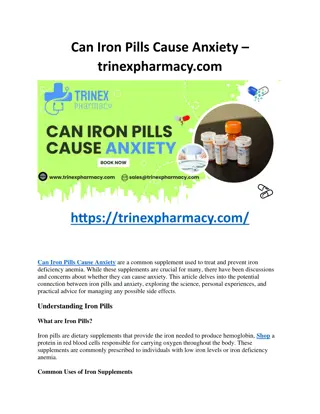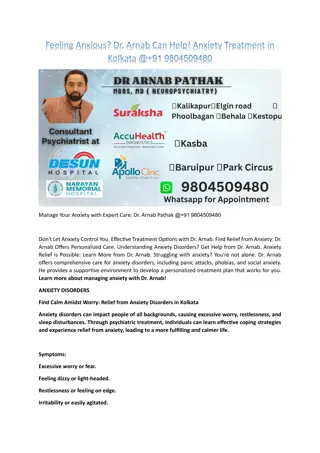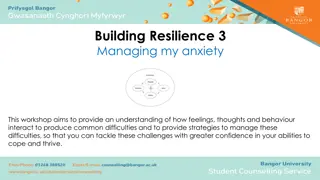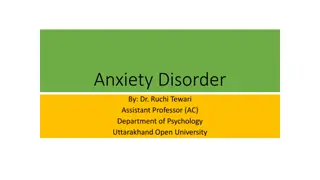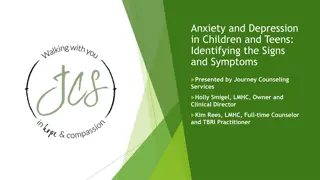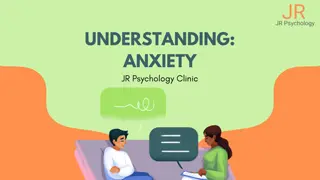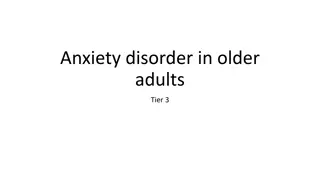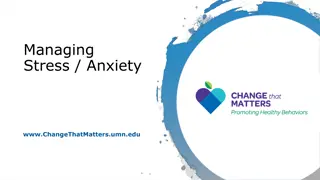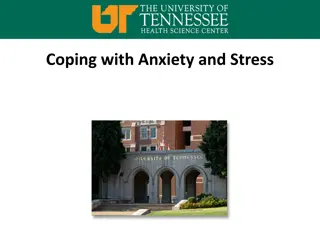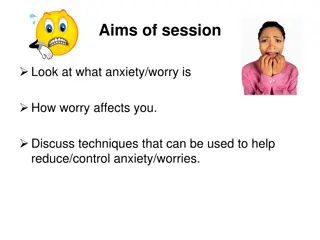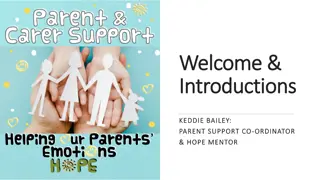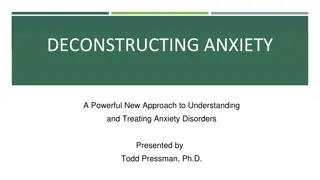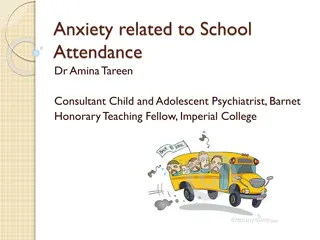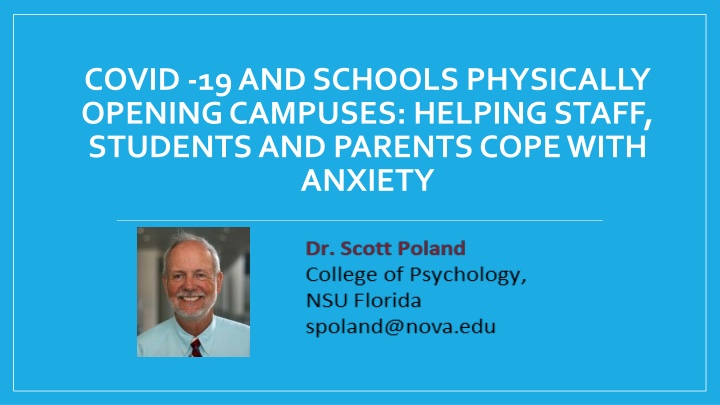
Supporting Schools in Managing COVID-19 Anxiety
Addressing the challenges faced during physical school closures, reopening dilemmas, and educational models amidst the pandemic. Explore effective strategies for handling anxiety among staff, students, and parents.
Download Presentation

Please find below an Image/Link to download the presentation.
The content on the website is provided AS IS for your information and personal use only. It may not be sold, licensed, or shared on other websites without obtaining consent from the author. If you encounter any issues during the download, it is possible that the publisher has removed the file from their server.
You are allowed to download the files provided on this website for personal or commercial use, subject to the condition that they are used lawfully. All files are the property of their respective owners.
The content on the website is provided AS IS for your information and personal use only. It may not be sold, licensed, or shared on other websites without obtaining consent from the author.
E N D
Presentation Transcript
COVID -19 AND SCHOOLS PHYSICALLY OPENING CAMPUSES: HELPING STAFF, STUDENTS AND PARENTS COPE WITH ANXIETY
Key issues about last years early physical school closure: Many students lost out on key academic concepts normally taught in the spring due to either lack of internet access or being unable to learn as well as having a teacher in the classroom. Many students were disappointed at not being able to participate in spring activities that they were looking forward to in sports, fine arts, school dances, and celebrations for milestones in academic achievement. Normal transition activities from one school level to another did not take place in the traditional fashion.
Key issues about returning to school campuses: Decisions about physical school reopening were left to local authorities with a major focus on virus transmission levels in the community. National polls have found approximately 40% of parents were considering home schooling their child for the fall of 2020. Immediately upon school reopening, some data indicated that 1 out of 4 students had not returned to public school. At this time, the CDC has indicated that children can and have been contracting the virus. The necessity of following safety guidelines in school and at home is imperative! Parents were faced with a very difficult decision about whether or not to send their child back to a school campus. Students who returned to a campus have discovered how different things are and hopefully how important it is to follow the safety recommendations. Locally only approximately 20% of students have returned to a campus. Some schools received criticism for not following social distancing guidelines. Schools have struggled with how to respond when staff or students contract the virus and whether or not to close the campus. Mask wearing has been politicized and not all schools are requiring them.
Examples of models for facilitating student education: Several models have been implemented: Virtual (online) school only for all students Hybrid model with a portion of students on campus a few days a week with virtual school the other days Some students return to campus 5 days a week Home schooling Single family with a teacher/facilitator Pods- multiple families combining children with a teacher/facilitator
Lets review my StayC.A.L.M. model C is for calmness, control what you can communicate, know and evaluate your local school plan and safety procedures for the fall semester. A is for being available for staff, students and parents. Lis for listening to the input from everyone. Mis for modeling coping with anxiety and fear related to COVID-19 and the fall semester and managementof virtual learning in our homes and closely monitoring children's behavior .
How did you do as a school administrator ? C - Did you collaborate and communicate with stakeholders before re- entry and during the first several weeks of implementation? A - Did you make yourself available to staff, parents, and students throughout re- entry? L- Did you listen to the input from staff, students, and parents? M- Did you and your staff model coping skills during re-entry?
Parents and staff are still coping with anxiety about school reopening. Remember these tips: Encourage them to take a deep breath and recognize things will get better and say: I can manage this and I will model optimism and hope for everyone. I will get some exercise and seek out the people in my life who are positive and I will be positive for others. I will implement a self-care plan for myself and encourage self-care for everyone. I know my reaction has been and will continue to be the most important factor in how children respond to the changes in life the virus has brought about. Whatever the selected school option was for my children this fall, it is important that I put all my efforts into making it work!
Measures we must continue in our schools and homes to prevent the spread of the virus. We have been given clear and very important directions from medical authorities on how to reduce the spread of the virus: Social distancing Washing our hands frequently and thoroughly Covering our mouth if we cough Wearing a mask Stay home if we have any symptoms of the virus Avoiding large gatherings This is something we can and do control. Children respond best when they know specific actions they can take.
ABCDs of COVID-19! Always wear a mask when inside somewhere besides your own home and wear your mask outside when you can not physically distance. It is our defense and everyone staff, parents and students need to think of it like wearing a seatbelt. Be aware of illness symptoms and students should be checked for symptoms prior to leaving home. Students must stay home if they have a fever or any symptoms. Schools need parents to pick their children up promptly if they become ill at school. Cleaning at schools will be extensive and some districts are planning Wednesday as a day without students for deep cleaning. Distance physically and stay 6 feet apart from others at school. Students will need frequent reminders and areas in classrooms clearly marked off for a visual reminder.
Lets review the measures taken to prevent the spread of the virus Did you and your team/family follow all the guidelines? What were the challenges? How did you overcome these challenges? What additional steps need to be implemented? What additional resources are needed? Who is your go to person to help you achieve these goals and monitor the virus in your school and community?
Remember the characteristics of child trauma: The typical reactions children have to trauma are: Regression - academically and behaviorally; Nightmares/sleeping problems; and Worry about the future. Some children and families may have had a very difficult time while quarantined. Now that school has been underway for some time virtually you should know: Which children lost loved ones to the virus. Which families experienced and continue to experience financial hardship. Be alert to warning signs of child abuse.
Lessons as a crisis responder Primarily I listen. But, one question that I always ask is, Who or what has helped you when you have had to deal with difficult things before and who or what can help you now? Remember that children who live in a stable home and are shown unconditional love can overcome almost anything. School administrators help staff, students and parents by being visible and available! Schools have often underestimated the impact of traumatic events. It is never to late to provide an opportunity for staff and students to talk about what they have gone through. Suicides often increase after traumatic events.
Objectives of the Teachable Moment lesson plan Students will understand the facts about COVID-19. Students have the opportunity to express their own experiences and emotions. Students will explore alternative responses to manage their emotions. Student have the opportunity to share their fears and concerns about their own safety. Students will understand the safety procedures in place in their school and community and their important role in safety. Students will be able to express empathy for those affected by the virus. Dr. Scott Poland-COVID 19 Re-entry
Youth Suicide: Suicide is the second leading cause of death for students 10 years of age and older. Which students might be most at risk: those with pre-existing mental health issues; those that lost loved ones to the virus; and those now living in poverty for the first time. It is important to review the school suicide prevention plan and ensure that all staff know the warning signs of suicide and the referral procedures in place at school. Parents must be notified if their child is suspected of being suicidal and a referral made to community providers with follow up at school.
Questions to ask your staff, students, and parents: How have you and your family been doing during the pandemic? Did anyone in your family catch the virus and do you know anyone who died from the virus? How are your students/children doing with virtual learning? How do you feel about a physical return to a school campus? What would help you feel safer about a physical return to a school campus?
Two types of anxiety are expected First, fear of catching the virus upon returning to a school campus. This is the primary concern and many staff and parents are overwhelmed, fearful and unsure how to protect their children! Second, fear that your students/children are significantly behind academically after having missed key benchmark subject skills normally taught in the spring. This is more of a concern for children at the secondary level than at the elementary level.
Identifying struggling students Refusal to attend school or inconsistent attendance. Excessive anxiety which might include extensive cleaning rituals. Appears sad or withdrawn. Exhibiting more aggressive behavior or outbursts that are not normal for them. Making statements verbally or in writing about hopelessness and frustration related to the virus. Concentration difficulties and academic performance that it is below expectations for them (please check with their teacher for the spring of 2020 for comparative information).
What Does the CDC say about children and COVID-19? New data suggests children do get COVID-19, have less severe symptoms, but can carry the virus to vulnerable adults. Most children contract the virus from a family member. Children who have medically complex conditions are more at risk for complications from COVID-19. While uncommon, rare illnesses and deaths from the virus may occur. The risk of getting COVID-19 is influenced by the transmission rate in your community.
A Review: CDC Decision Tree Considerations How are your students doing with virtual instruction? How are they managing the social isolation? Is anyone in your school at increased risk for severe illness if they contract the virus? What are the risks and benefits of your students returning to a school campus? How important are school support services for meals, mental health, extended day care and extra curricular activities for your students? Will your school be able to follow the recommended guidelines from the CDC?
CDC Decision Tree Questions to Evaluate Virtual Learning How well did students do with virtual learning? Did students have someone in their home to supervise virtual learning? Did students have reliable internet and devices for virtual learning? Will students be engaged and learn at a reasonable level if school is only virtual? Will students be engaged socially at a reasonable level if school is only virtual?
CDC Recommendations for Schools Promoting behaviors that reduce the spread of the virus (physical distancing, washing hands and wearing masks). Maintaining healthy environments (ensuring proper ventilation, cleaning and disinfecting frequently touched surfaces). Maintaining healthy operations (staggering student schedules, keeping students in small groups and limiting movement around the school). Preparation for when a student or staff member becomes ill with the virus.
All schools should have a COVID-19 Student Safety Pledge!
Sample COVID-19 Safety Pledge COVID-19 Safety Pledge Introduction for your school: At this time of re-entry to school during the COVID-19 pandemic, we are working on ensuring school safety for everyone. The COVID -19 Safety Pledge includes safety steps for students whether they are in our school, at home, or in the community. Our students need to think smart and know the healthy practices that will keep them safe and others safe and allow our school to stay open physically. Our schools and students in (school district) have participated and supported safety pledges in the past. Now we bring you a COVID-19 Safety Pledge for school and home. Check list of points for student commitment: I will wash my hands and sanitize to kill germs and save lives. I will wear a mask in places required at all times, or when asked by an adult. Without a mask, I will sneeze into my elbow or my sleeve. I won t share snacks, food, or beverages. I will tell a teacher or staff member if I am worried about a safety concern. I will stay home if I am not feeling well. I will tell a teacher if I begin feeling ill at school Student signature: Parent signature: Date:
Questions school leadership and parents would have considered when deciding upon the appropriate school instruction model Determine when you must make the decision and is the decision final? What are the school options for the fall? What are the unique issues for the family and their children? What are the benefits of children returning to a school campus? What are the risks of children returning to a school campus? What are the benefits of virtual learning? What are the limitations of virtual learning for my children? Once you make a decision accept it and do everything you can to help your student/child to stay healthy and be successful!
Signs of stress may continue or escalate as school gets underway Anxiety, worry and fear Feeling on the edge Changes in appetite, energy, and activity levels Sleeping problems Concentration problems Increased irritability Increased use of drugs and alcohol Verbalizing thoughts of hopelessness and thoughts of suicide
Helping everyone manage stress Encourage self-care plans. Remind everyone that we choose how we respond. Encourage staying in the moment and not worrying about things that have not happened. Encourage everyone to connect with others for support with social distancing.
Did you do the following as the adult when talking with children about the virus? Most importantly listen and validate their feelings. Find out what they know about the virus and don t dismiss their fears. Acknowledge that what has happened is unprecedented. Be honest when you do not know the answer to their questions. Let them express their emotions through talking, writing, music or artwork. Acknowledge you are concerned and the virus is contagious and we do not know how widely it will spread but the majority of people who contract the virus have only minor symptoms and recover.
Did you do the following when talking with children about the virus? Emphasize that the school is following all the recommendations from heath officials and the smartest scientists in the world are working on a treatment and cure for the virus. Ask the child what would help them feel safer right now? Emphasize the ABCDs. Avoid the discussion of politics and criticism of national and state leaders. Talk about the heroic actions of medical personnel and suggest writing letters of thanks to them.
Were you alert to the following developmental reactions in children? Preschool: toileting problems, sleeping problems, bed wetting, decreased appetite, increased temper tantrums, more clingy or whiny, and fearful of being alone. Older preschoolers may understand the effects of the outbreak and will look to adults to see how upset to be. Elementary School: increased need for adult attention, increased aggression and irritability, somatic complaints, sleeping problems, and concentration problems with school work. Middle school and high school: increased somatic complaints, agitation or apathy, concentration problems with school work, increased substance abuse, and withdrawal from others.
Review: The Cycle of Normal Stressors Work Demands Need for Family Demands Self-Care Fatigue/ Stress
Did you develop and follow a self-care plan? Physical self-care includes diet, exercise and proper rest. Mental self-care includes attending to your emotional needs by talking to other adults and examining the problem outside of your body. Let go of self criticism as everyone has made mistakes in the face of the pandemic. Express your thoughts and emotions through journaling, painting, drawing, gardening, and other creative avenues.
Staff, parents, and older children's self- care plan components: Spiritual self-care, even if you are not religious, includes living by a set of values you wish for others (compassion, empathy, friendliness, helpfulness, humor, and respectfulness). Embrace nature by spending time outdoors. Model good values by being that positive person for your family and others! Engage in I can statements ; I can relax myself by-, make myself happy by-, exercise by-, relieve stress by-, be a good friend by-, help others by-, eat healthy by-, and get proper rest by-
Younger children self-care plans I CAN EAT HEALTHY BY... PICTURE OF ME! I CAN EXERCISE BY... I CAN BE HAPPY BY... I CAN HELP OTHERS BY...
Recommendations from Dr. Laurie Santos at Yale Whose Happiness Class Is Popular We have misconceptions about happiness and things a simple as a chit chat with a stranger at a coffee shop affect us positively but it is harder now we need to double down on our social connections. Time is precious now and don t let technology consume you pay attention to the people in your life talk to them don t just sit there looking at Apps on your phone. We assume self care looks like a nice bubble bath but the data suggests the right way to treat ourselves is to do nice things for others! During COVID use the tools we have for example a quick caring text to a friend, surprise someone with a gift. Show gratitude to those in your life. During COVID don t run away from negative emotions use meditation to recognize them (RAIN: recognize, accept, investigate and nurture) You can deal with them! www.happinesslab.fm
Final thoughts on school in the fall If schools entered the fall semester with plans that were constructed after careful input from health officials, staff, parents, and students, the chances of success and support of the plan will be greatly increased. There is no way to know exactly what is the right or wrong decision for your students/children. Once the decision is made, accept it and the feelings that accompany it. Accept you will be conflicted as not even physicians can make promises of safety for our children. You can feel good about the process you went through to make the decision. Continue to encourage staff and parents to support the decisions and provide input throughout the implementation process. The ability of schools to stay open physically will be affected by the behavior of students and staff. Teachers are working very hard to teach students in person and those on line at the same time. Schools are doing the best they can to balance the educational, health and safety needs of students without all the needed data and tools.
Resources CDC School Decision-Making Tool CDC School Decision-Making Tool https://www.cdc.gov/coronavirus/2019-ncov/community/schools- childcare/decision-tool.html National Association of School Psychologists www.nasponline.org

